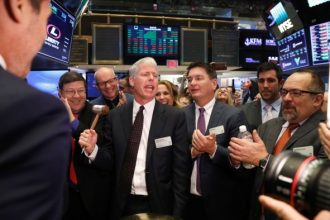Goodbye, cheap money. And good riddance.
The era of extremely low interest rates has faded further into the rearview mirror as the Federal Reserve continued a series of interest rate hikes that began in March 2022. This year saw returns on cash and short-term instruments hit levels that really became attractive to investors, who found they could earn 5% in a money-market fund or near that in a bond fund.
In other words, stocks faced real competition.
That served to drive home the end of what investors had come to known as “TINA” — an acronym for “there is no alternative” to equities.
The term was popularized in the wake of the 2008 financial crisis by an April 2013 guest column in The Wall Street Journal by Jason Trennert. The idea is that as the Federal Reserve bought up long-term bonds and kept official interest rates near zero, investors had little choice but to look to equities for returns.
TINA proved to be a long-lived phenomenon and its aftereffects linger, Trennert, chairman and CEO at Strategas Research Partners, a macro research firm, told MarketWatch in an interview earlier this month. But in many ways it is a new world for investors as many of the distortions created by more than a decade of central bank quantitative easing and ultraloose monetary policy fade away, he said.
The distortions were many. The point of QE was to make traditionally safe assets less appealing, forcing investors to seek out riskier investments on the expectation that would help fuel economic growth.
The consequence, as described by investor and author Edward Chancellor in “The Price of Time: The Real Story of Interest,” was a bubble in virtually every asset class.
With the cost of capital low, investors were more willing to pour money into companies and startups whose profit potential lay well off in the future. Thousands of unicorns — startups valued at more than $1 billion — were born. A financial system sloshing with liquidity may have facilitated rampant speculation in cryptocurrencies and meme stocks.
It also helped suppress macroeconomic and market volatility, stoking bull markets in both stocks and bonds, but also took away the reward that came with having “investment insight,” wrote strategists at BlackRock Investment Institute, in a Dec. 11 note.
They illustrated the concept in the chart below.
Here’s how they describe the test: “Imagine you could perfectly predict future U.S. equity sector returns and adjust your portfolio to capture them. That would have had little upside in the four years before the pandemic.”
The chart on the left above shows that “buy-and-hold” strategies, illustrated by the orange bar, would have generated similar returns to portfolios allocating to outperforming sectors more frequently, represented by the yellow and green bars.
The reward has been much greater since the pandemic, as shown on the right, with rebalancing delivering more than double the hypothetical returns of a buy-and-hold strategy.
In other words, stock pickers stand to get rewarded once again.
Elsewhere, the housing market, and therefore a large number of consumers, benefited from cheap financing through low mortgage rates, zero- or near-zero-percent auto loans and consumer credit, via zero-interest financing for consumer purchases and credit-card transfers, noted Jeff Klingelhofer and Rob Costello of Thornburg Investment Management, in a Dec. 8 note. At the same time, corporate and government debt expanded to record levels as a percentage of GDP, they observed.
“Though easy to imagine in hindsight, a borrower, even an everyday consumer, could roll short-term debt at or near zero rates for years, essentially financing either consumption or investment free of cost,” Klingelhofer and Costello wrote. “This is no longer the case.”
The consequences of the end of cheap money are being felt in the stock market. Trennert noted that 42% of companies in the small-cap Russell 2000 were without profits in the last 12 months. Companies are increasingly being forced to make profits or go out of business as the cost of capital rises.
“Highly leveraged companies without profits are going to continue to have a tough time,” he said.
That said, the full effects of the shift to a quantitative tightening monetary policy are yet to be felt, Trennert said. Market watchers have noted that bank reserves have remained elevated, helping to preserve liquidity and damping the effect of the Fed’s quantitative tightening measures so far.
Related: How a shrinking cash pile at the Fed can aid liquidity in the $26 trillion Treasury market
The adjustment to rising interest rates was brutal in 2022. The S&P 500
SPX
produced a negative-18% return while bonds, by some measures, saw their worst year on record, as Fed rate hikes sent Treasury yields soaring. — delivering a rare double whammy. Usually bonds are expected to provide a cushion.
Read: What investors can expect in 2024 after a 2-year battle with the bond market
Check out: The VIX says stocks are ‘reliably in a bull market’ heading into 2024. Here’s how to read it.
This year, stocks have soared, though the rally has been uncharacteristically narrow for a young bull market, with megacap tech stocks dominating gains and providing much of the fuel for the S&P 500’s year-to-date gain of more than 20%.
Meanwhile, stocks, bonds, crypto and gold have all enjoyed a renewed “everything rally” as year-end approaches, fueled by a retreat in bond yields from roughly 16-year highs seen in late October. Yields fall as debt prices rise.
But investors should expect returns to be lower from here because the cost of capital will no longer be subsidized by the central bank, barring a change of heart by the Fed, Trennert said.
Legendary investor Howard Marks last year described the TINA era as the culmination of a 40-year sweep of falling bond yields. The co-chairman of Oaktree Capital Management argued that investors now face a generational “sea change.” At the least, the playbook that worked in the aftermath of the financial crisis will no longer apply.
“We’ve gone from the low-return world of 2009-21 to a full-return world, and it may become more so in the near term,” he wrote in a December 2022 memo to clients. “Investors can now potentially get solid returns from credit instruments, meaning they no longer have to rely as heavily on riskier investments to achieve their overall return targets.”
Still, many investors remain underweight fixed-income in their portfolios. Instead, “what we’ve seen over the last year is a lot of people parking money in cash,” said Lauren Goodwin, economist and portfolio manager at New York Life Investments, in aninterview.
That’s understandable given macroeconomic uncertainty, “but if 2023 has told investors anything, it’s that sitting it out isn’t the answer and we know that historically cash does not yield positive, even risk-adjusted, returns,” Goodwin said.
Related: Here’s the danger for investors in holding too much cash
Investors parked in cash, meanwhile, face reinvestment risk and missing out on the renewed income cushion now provided by bonds. New York Life expects the U.S. economy to fall into a mild recession in 2024. The market typically recovers faster than the economy, but as the Fed cuts rates, investors would need to move out of cash at a time that would feel very challenging, Goodwin said.
See: ‘Cash is a trap,’ warns JPMorgan’s David Kelly. Here’s how a traditional mix of stocks and bonds may pay off.
The recession scenario would likely see investors move toward a “modified” 60/40 portfolio that favors more exposure to bonds and real assets, as well as infrastructure, technology and artificial intelligence, she said.
Trennert said investors over the long run will likely need to get used to higher bond yields. Part of that is due to the run-up in U.S. government debt, which will require refinancing at higher rates.
It’s also a function of the reversal of the trend toward increased globalization that had been in place since the fall of the Berlin Wall in 1989, he said, which contributes to higher inflation and higher interest rates.
There is an outside chance that an AI-fueled surge in productivity or other advances will serve as a “deus ex machina” that saves the day “despite our best efforts to screw everything up,” Trennert said, but investors shouldn’t count on it.
“I would say that barring a step-function higher in productivity, it seems to me it gets very hard to be long-term bullish on bonds, he said.
Read the full article here





